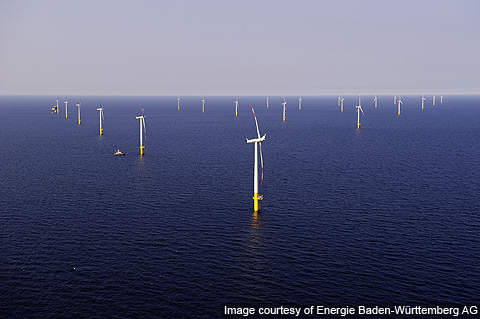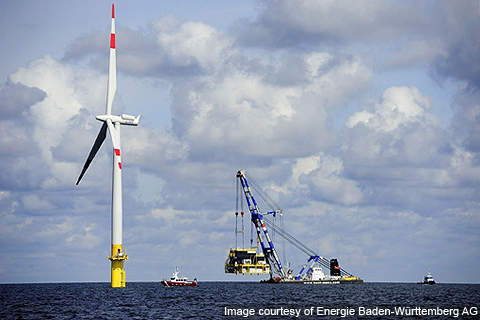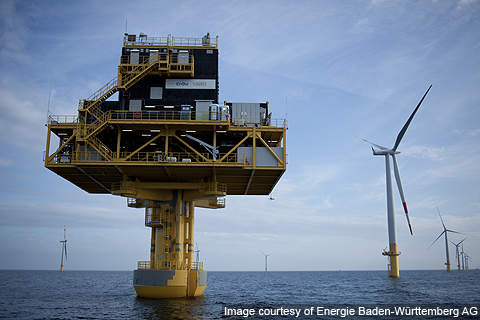Baltic 1 Offshore Wind Farm is Germany’s first commercial offshore power project located in the Baltic Sea. It has an installed capacity of 48.3MW which is sufficient to power 50,000 homes. It is owned and operated by EnBW Energie Baden-Württemberg of Germany.
Baltic 1 is one of the four offshore projects won by EnBW in 2008. The four projects together will have an output of 1,200MW. The total cost of the projects is around €3bn.
The foundation for Baltic 1 was laid in the second quarter of 2010. The project was commissioned in May 2011. It will contribute to Germany’s renewable energy target of 30% by 2020. Germany aims to generate 25,000MW of electricity from offshore wind parks by the end 2030. In order to achieve this goal, the German Government began a €5bn programme in June 2011 for the development of offshore wind energy.
Project finance
The Baltic 1 project financing was structured and completed in December 2011. A bank consortium of the European Investment Bank (EIB), KfW IPEX-Bank, Landesbank Baden-Württemberg (LBBW) and NIBC Bank, has arranged a loan of €138m. A loan of €80m, committed by EIB in March 2011, is incorporated in the structured finance. The remaining €58m is being provided by other partners in the consortium.
Baltic 1 wind farm details
Baltic 1 is situated 16km north of the Daras / Zingst coastal towns and is expected to generate 185GWh a year.
It has 21 Siemens wind turbines spread over an area of seven square kilometres in the Baltic Sea. The wind speed at the plant site is 9m/s.
Each turbine has a rotor diameter of 93m and rated capacity of 2.3MW. The turbines are installed on the transition piece fixed to the monopiles laid 16m-19m deep inside the sea bed. Each monopile weighs 250t. It is 30m tall with a maximum diameter of 5.3m. The transition piece with ice cone is 31m tall with 5.7m diameter. It weighs 1,000t.
The substation platform (22m x 30m x 16m) is located 16km from Mecklenburg-Vorpommern coast line. It is equipped with step-up transformer and gas-insulated medium voltage switchgear with all protection and process control technology. The power reaching the substation is stepped up from 33kV to 150kV by the transformer.
Distribution
The stepped-up electricity is transported to on-shore near the coast through a 61km long, three-phased sub-sea cable. The cable is buried 1.5m deep in the sea-bed to protect from sea-anchors and fishing activities. A ‘Capjet ‘ trenching system was used to bury the cable into the sea-bed.
The ground cable from the coast is connected to the Bentwisch substation from where the electricity is distributed to the main network.
Development and construction
The design and installation of the foundations was carried out by Ballast Nedam under a contract that was signed in 2008. The foundations were lifted by the company’s heavy lift vessel Svanen.
Grilling and sea fastening design was provided by H2 Offshore Engineering (H2OE) under a sub-contract with Ballast Nedam.
The foundations have been supplied by Erndtebrücker Eisenwerk under a contractual agreement signed in January 2009. Scour protection for the foundations was provided by Peter Madsen Rederi.
A2SEA was subcontracted by Siemens to ship the wind turbines from Denmark.
Conceptual design of the transformer platform was provided by Balslev. The design included electrical infrastructure, ventilation, plumbing and fire protection system. In addition, Balslev carried out simulation tests of the transformer island for different loads and short circuit conditions.
All the electrical equipment required to distribute power from the offshore substation have been supplied by ABB. The platform was manufactured and fabricated by Waserwind.
The export subsea cables were manufactured by NKT Cables, a subsidiary of NKT Holding, and connected to the grid in association with 50 Hertz.
The ‘Capjet’ trenching system is an in-house system developed by Nexans. This machinery was hired by EnBW to bury the power export cables.
Future
After the commissioning of Baltic 1 offshore wind farm, EnBW has awarded contracts for the construction of Baltic 2. Formerly known as "Kriegers Flak", the Baltic 2 is scheduled to be completed in 2013. The project is scheduled to start in 2012 and upon completion the Baltic 2 will have a total installed capacity of 288MW.






